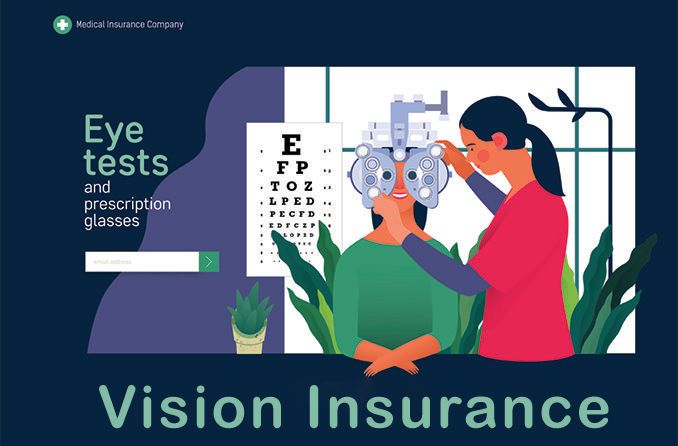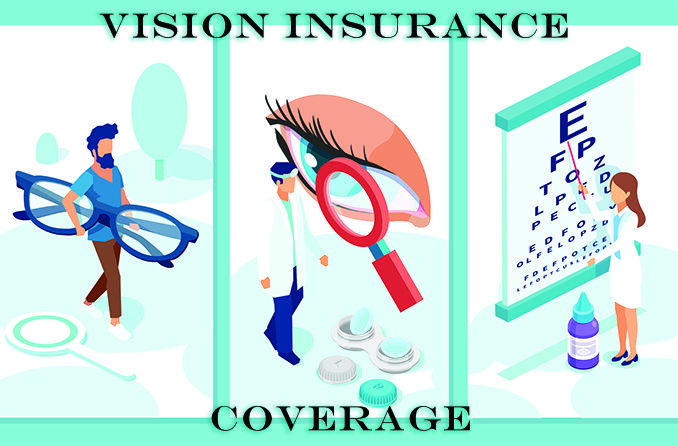Comprehensive Guide to Vision Insurance
Vision insurance is a type of health coverage specifically designed to help cover the costs of eye care. This includes routine eye exams, prescription glasses, contact lenses, and sometimes even corrective surgeries like LASIK. Vision insurance is crucial for maintaining eye health, preventing vision problems, and reducing the financial burden associated with eye care.

Table of Contents
Sun Life Insurance Claim: A Comprehensive Guide 2024
Sun Life Insurance Claim: A Comprehensive Guide 2024 Navigating the process of filing an insurance c…
Professional Liability Insurance: Best Guide 2024
A Comprehensive Guide to Professional Liability Insurance (Errors & Omissions) Professional liab…
Understanding TATA AIG Insurance: A Comprehensive Guide 2024
Regarding securing the future, nothing stands out quite like insurance. It’s the comforting cushion …
Understanding Ladder Life Insurance 2024: Climbing the Rungs of Financial Security
Ladder Life Insurance: When it comes to securing your financial future and providing for your loved …
Best Guide to Motorcycle Insurance 2024
A Comprehensive Guide to Motorcycle Insurance Motorcycle insurance is essential for protecting rider…
Allstate Car Insurance: Comprehensive Coverage and Benefits 2024
Allstate Car Insurance, one of the largest insurance providers in the United States, offers a range …
Importance of Vision Insurance
Vision insurance is essential for several reasons:
- Preventive Care: It encourages regular eye exams, which are vital for detecting eye conditions and vision changes early.
- Cost Savings: It helps reduce out-of-pocket costs for eye exams, glasses, and contact lenses.
- Eye Health: Good vision health is linked to overall health. Vision insurance supports maintaining healthy eyesight and preventing eye diseases.
- Financial Protection: It provides financial protection against unexpected eye care expenses, making vision care more affordable and accessible.

Types of Vision Insurance Plans
Vision insurance plans come in various forms, each with distinct features, coverage levels, and costs:
1. Vision Benefits Packages
Vision benefits packages are traditional vision insurance plans that cover specific services and products. These plans typically have a network of providers and offer benefits like routine eye exams, a set allowance for glasses or contact lenses, and discounts on additional services. Members pay a premium, and the plan covers a portion of the costs.
2. Discount Vision Plans
Discount vision plans are not insurance but provide discounts on eye care services and products. Members pay an annual fee to access discounted rates for eye exams, glasses, contact lenses, and sometimes even corrective surgeries. These plans can be a cost-effective option for those without traditional vision insurance.
3. Vision Savings Plans
Similar to discount plans, vision savings plans involve paying an annual membership fee to access reduced rates for vision care services. They are suitable for individuals who want to save on eye care without paying high insurance premiums.

Coverage Levels in Vision Insurance
Vision insurance plans typically categorize coverage into three main levels:
- Routine Eye Exams: Includes comprehensive eye exams, which assess vision and check for eye diseases. Most plans cover routine eye exams annually or biennially, often with a copayment.
- Eyewear: Includes prescription glasses and contact lenses. Plans may offer a set allowance for eyewear or discounts on the purchase of glasses and lenses.
- Additional Services: Some plans cover additional services like corrective surgeries (e.g., LASIK), lens coatings, and specialty contact lenses. Coverage for these services varies by plan.
Choosing the Right Vision Insurance Plan
Selecting the right vision insurance plan involves considering various factors:
- Budget: Determine how much you can afford to pay in premiums and out-of-pocket costs.
- Vision Needs: Assess your vision health needs, including any ongoing treatments, potential eyewear purchases, and family members’ vision care.
- Coverage: Review the coverage details, including the percentage of costs covered for routine eye exams, eyewear, and additional services.
- Network: Check if your preferred eye care providers are in the plan’s network.
- Frequency of Exams: Be aware of how often the plan covers routine eye exams (annually or biennially).

Understanding Vision Insurance Terms
Familiarizing yourself with common vision insurance terms can help you navigate your plan more effectively:
- Premium: The amount you pay monthly or annually for vision insurance coverage.
- Deductible: The amount you pay out-of-pocket before your insurance begins to cover costs.
- Coinsurance: The percentage of costs you share with the insurance company after meeting the deductible.
- Copayment: A fixed amount you pay for a specific service, such as an eye exam or eyewear purchase.
- Annual Maximum: The maximum amount the insurance company will pay for covered services in a plan year.
- Exclusions: Services or products not covered by the insurance plan.
- Allowance: A set amount the plan provides for specific services or products, such as glasses or contact lenses.
Benefits of Vision Insurance
Vision insurance offers numerous benefits:
- Access to Care: Ensures access to necessary eye care and routine eye exams.
- Cost Management: Helps manage the cost of vision care and reduces out-of-pocket expenses.
- Health Benefits: Supports overall health by maintaining good vision and preventing eye diseases.
- Peace of Mind: Provides peace of mind knowing that you have coverage for vision emergencies and significant eye care needs.
- Regular Check-ups: Encourages regular eye exams, leading to early detection and treatment of vision problems.
Challenges of Vision Insurance
Despite its benefits, vision insurance also presents challenges:
- Cost: Premiums, deductibles, and out-of-pocket costs can add up, especially for specialty eyewear or corrective surgeries.
- Coverage Limits: Annual maximums and exclusions can limit the amount of coverage available.
- Network Restrictions: Some plans limit the choice of eye care providers to those within the network.
- Frequency Limitations: Coverage for routine eye exams may be limited to once per year or every two years.
Tips for Maximizing Vision Insurance Benefits
To make the most of your vision insurance, consider the following tips:
- Utilize Preventive Care: Take advantage of covered routine eye exams to maintain good vision health.
- Plan for Eyewear Purchases: Use your plan’s allowance or discounts for glasses and contact lenses to reduce out-of-pocket costs.
- Understand Your Plan: Familiarize yourself with your plan’s coverage, exclusions, and frequency limitations to avoid surprises.
- Choose In-Network Providers: Use in-network eye care providers to reduce out-of-pocket costs.
- Track Your Expenses: Keep track of your vision care expenses and monitor your progress toward the annual maximum.

Enrollment and Eligibility
Eligibility and enrollment in vision insurance depend on the type of plan and the provider. Many employers offer vision insurance as part of their benefits package. For those without employer-sponsored coverage, vision insurance can be purchased through private insurers or health insurance marketplaces.
Vision Insurance for Families
Family vision insurance plans cover multiple members of a household. These plans offer significant benefits for families with children, as regular eye exams are crucial for detecting vision problems early in life. Coverage typically includes routine eye exams, glasses, and contact lenses for each covered family member.
Vision Insurance and Overall Health
Regular eye exams can reveal more than just vision problems. Eye doctors can detect signs of other health issues, such as diabetes, high blood pressure, and high cholesterol, during a routine eye exam. Vision insurance supports overall health by promoting regular eye exams and early detection of these conditions.
Vision Insurance and Aging
As individuals age, the risk of eye diseases like glaucoma, cataracts, and macular degeneration increases. Vision insurance is particularly important for older adults, as it helps cover the costs of regular eye exams and treatments for age-related eye conditions. Ensuring adequate vision insurance coverage is crucial for maintaining eye health and quality of life in older age.
Conclusion
Vision insurance is a valuable tool for maintaining eye health and managing the costs of vision care. By understanding the different types of vision insurance plans, coverage levels, and key terms, individuals and families can make informed decisions about their vision insurance needs. Despite the challenges, the benefits of vision insurance make it an essential part of a comprehensive health care plan. Regular eye exams, access to necessary eyewear, and early detection of vision problems are crucial for overall health and well-being.








4 comments
[…] Vision Insurance: A Comprehensive Guide 2024 […]
[…] Term life insurance is one of the most straightforward and cost-effective types of life insurance available. It provides financial protection for a specified period, or “term,” and is designed to offer a death benefit to your beneficiaries if you pass away during this period. This guide delves deep into term life insurance, exploring its features, benefits, drawbacks, and considerations to help you make an informed decision. Vision Insurance: A Comprehensive Guide 2024 […]
[…] Whole life insurance is a type of permanent life insurance that provides lifelong coverage and includes a cash value component. Unlike term life insurance, which covers you for a specific period, whole life insurance remains in force as long as you continue to pay the premiums. This guide delves into the details of whole life insurance, including its features, benefits, drawbacks, and considerations to help you make an informed decision. Vision Insurance: A Comprehensive Guide 2024 […]
[…] Universal life insurance (UL) is a type of permanent life insurance that offers flexible premiums, a savings component, and lifetime coverage. It provides a combination of death benefit protection and cash value accumulation, making it a versatile financial tool for many policyholders. This guide explores the features, benefits, drawbacks, and considerations of universal life insurance to help you make an informed decision. Vision Insurance: A Comprehensive Guide 2024 […]